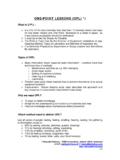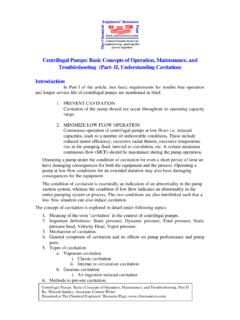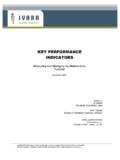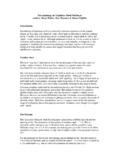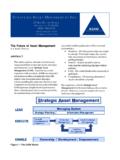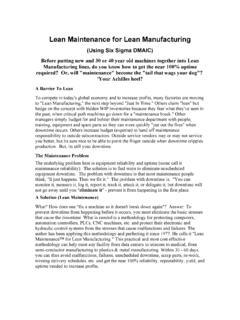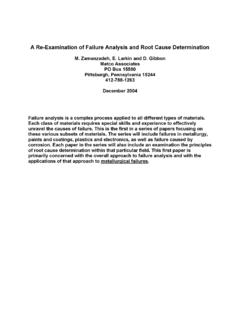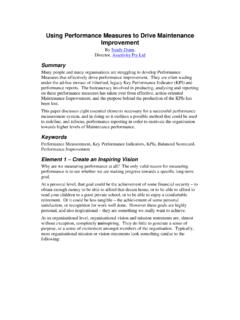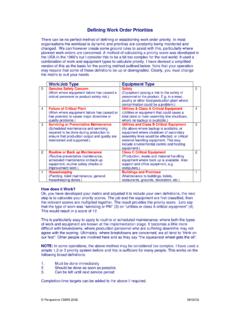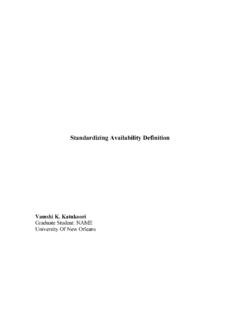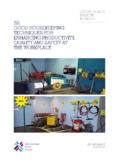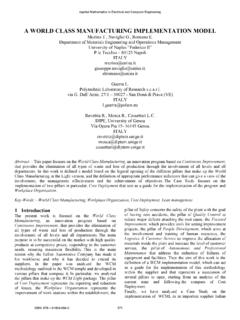Transcription of 5S: Workplace organization and standardization
1 5S: Workplace organization and standardization 5S is a process of work place organization and house keeping which is carried out gradually and systematically. The 5S method is a structured program to implement Workplace organisation and standardisation. A well organised Workplace motivates people, both on the shopfloor as well as others. 5S improves safety, work efficiency, improves productivity and establishes a sense of ownership. 5S is developed in Japan and stands for Seiri - Clearing up: remove what is not needed and keep what is needed Seiton - Organizing: place things in such a way that they can be easily reached whenever they are needed Seiso - Cleaning: Keep things clean and polished.
2 No trash or dirt in the Workplace Seiketsu - Standardizing: Maintain cleanliness after cleaning - perpetual cleaning Shitsuke - Self-discipline: Commitment, a typical teaching and attitude towards any undertaking to inspire pride and adherence to standards established for the four components Impact of 5S implementation reduce inventory, efficient on Workplace usage, reduce time for searching spare part, reduce oil / water / air spilled, reduce un-stabilization, preventive of machine function, cleaning&checking machine condition, improve working condition, reduce work accident, increase discipline, follow procedure, and better relationship among employee.
3 Keys to successful implementation of 5S GET EVERYONE INVOLVED: 5S is not be the responsibility of a concerned few. It is a concern of every one to act. All levels of management should take part in decision making required to ensure 5S implementation. Incorporate 5S activities as part of company s small group activities. GET COMPANY AUTHORIZATION: 5S activities should not be performed in a secret or disguised such as overtime work . Get management approval for all 5S activities. Make signs and posters as means to promote 5S for everyone.
4 Conduct a general monthly meeting where company and managers can address 5S issues and themes. FINAL RESPONSIBILITTY RESTS WITH THE PRESIDENT: The 5S s will not be taken seriously until the managers and even the company president take personal responsibility and interest on its implementation. Nothing could be worse for the success of 5S implementation than to have managers who pass the 5S implementation buck to their subordinates. Company managers must take a strong leadership role in 5S promotional meetings and other 5S events.
5 MAKE YOURSELVES UNDERSTOOD & AWARE OF: Don t leave people wondering Why are we sticking red tags on things? or Is all this 5S stuff really necessary before we can make any improvements? . Hold 5S promotional meetings to clearly explain 5S and to entertain all questions from all participants. Present actual examples of successful 5S implementation, or take participants on tour to successful 5S workplaces. DO IT ALL THE WAY: When establishing proper arrangement, make sure to carry out red tag campaigns and use correct red-tagging formats and procedures.
6 When establishing orderliness, use signboards. Make sure the signboards have proper format, descriptions, and locations. Prepare your company s own 5S manual, complete with all the necessary details. THE PRESIDENT SHOULD INSPECT THE GEMBA (SHOPFLOOR) PERSONALLY: The President should personally inspect offices and point out their various positive and negative conditions. The President should help by pointing out specific improvement items and proposing improvement themes at 5S promotional meetings. GEMBA should work individually as well as in groups to study and report on improvement methods taken in response to improvements suggested by the President.
7 DON T STOP HALFWAY IN ESTABLISHING 5S: Don t do things halfway. Once the 5S promotional organization and methods have been established, get started and stick with it. When developing red tagging and signboards throughout the company, make sure gets everyone involved. Once you have laid the foundation by establishing proper arrangement and orderliness, start developing discipline habit to keep the foundation strong. 5S IS A HALFWAY TOWARD OTHER IMPROVEMENTS: Don t stop with 5S: Follow through with Zero Defects, Cost Reduction, and other Productivity & Quality improvements.
8 Once the office has been cleaned up, start putting casters on drawer cases to make them easily movable. Eliminate defects as close to their source as possible and implement flow process. By implementing 5-S, eventually productivity, efficiency and working spirit will be promoted. It is not only useful to manage work place physically but also useful to develop employee s attitudes and discipline. (Noeradji Prabowo PQM Consultants e-mail: ) Reference Hirano, Hiroyuki. 5 Pillars of the Visual Workplace . Productivity Press, 1995. Hirano, Hiroyuki.
9 Putting 5S to work , Step-by-Step Approach. PHP Institute, 1993. Jahja, Kristianto. 5R (Ringkas, Rapi, Resik, Rawat, Rajin. Productivity and Quality Management Consultants, 1995. Jahja, Kristianto. Tantangan Industri Manufaktur, Penerapan Perbaikan Berkesinambungan. Productivity and Quality Management Consultants, 1991. Osada, Takashi. The 5S s, Five keys to a Total Quality Environment. Asian Productivity organization , 1991. Peterson, Jim & Smith, Roland, The 5S Pocket Guide. Productivity, 1986 Productivity Press Development Team, The.)
10 5S for Operators, 5 Pillars of the Visual Workplace . Productivity, 1996. Setiawan, Paulus A. Penerapan 5S di Tempat Kerja. Productivity and Quality Management Consultants, 1995. Singapore Productivity and Standards Board. 5S Good Housekeeping. PSB, 2000. Sugiyama, Tomoo. The 5S Approach to Improvement, 100 Illustrated Before & After Examples. PHP Institute, 1995. NOERADJI PRABOWO e-mail: & Noeradji Prabowo is one of the consultants in Productivity & Quality Management Consultants (PQMC) an institution providing services in consulting and training on Productivity & Quality Management.
